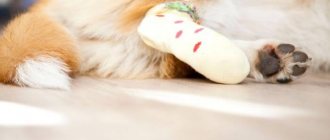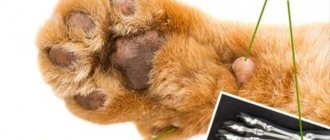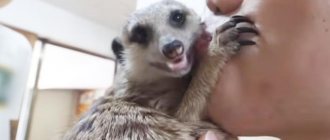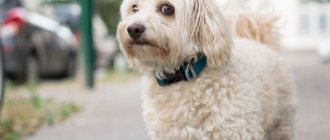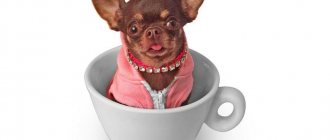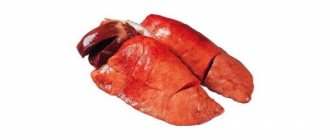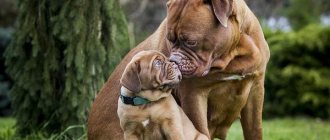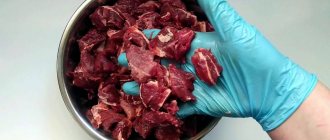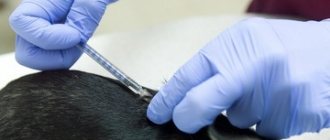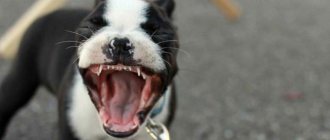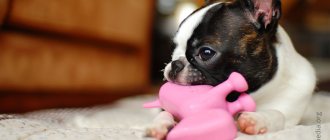Some four-legged pets are born with one extra toe that they do not use, and some have even more. Most often it forms on the front legs, but sometimes it occurs on the hind legs.
In the latter case, the additional shoot greatly worries owners who plan to present their pets at exhibitions. The most obvious solution in such cases seems to be surgery, but this is always associated with risks. There must be a compelling reason for surgery and a veterinarian should be consulted.
How does a dog's paw work?
Dogs are descendants of wolves who get their food by chasing, so their claws do not retract - unlike feline predators, who sit in “ambush”, waiting for the exact moment to strike - wolves always need to be ready to attack.
Depending on the breed, dog paws are divided into three different types according to the type of structure:
- "Cat" The most popular paw structure: a neat, rounded hand with connected toes and downward curved claws. The advantage of this type is that the animal’s claws do not need to be trimmed additionally. The “cat” structure is often found in purebred dogs; such paws very rarely have dewclaws.
- "Hare". An elongated paw with smooth, sharp claws is most often found in hunting dogs, small decorative breeds of dogs, or mongrels. An animal with this paw structure can use its claws both during a fight and during hunting or digging holes.
- "Wolf". Rounded, slightly elongated paws with a slight bend in the claws, the main function of which is to maintain balance during fast running.
Note! The structure of the paw does not affect how many toes a dog has - a puppy with atavisms can be born to any breed, regardless of its paw shape or origin.
How many fingers should dogs have normally?
The question of how many claws a dog has on its hind legs and how many toes interests not only people who have little contact with pets, but even those “experienced” dog breeders who have been working with various breeds for many years.
The number of toes can be determined by how many claws a dog has on a given paw.
Most of our “little brothers” have four toes on their front and hind limbs; sometimes you can find animals that have five or six toes. Additional toes can be only on one paw or symmetrically on both sides; if they grow on the pelvic limbs, they are often not divided into phalanges and are not connected to the leg bone.
Note! The “extra” fingers are called dewclaws.
The benefits of an extra finger
The presence of this atavism in domestic dogs does not in any way affect the health or condition of the pet - the anatomy of the animal is adapted to this rudiment, only in some cases it is necessary to monitor the paws more carefully. The fifth toe on the front paw helps the animal hold a ball or toy (just as its distant ancestors, wolves, do while hunting or eating), while the rudiment on the hind paw does not provide any additional benefit to the dog.
The dogs got their extra fingers from their long-time ancestor, the wolf.
Additional Information! A rudiment is a part of the body inherited from distant ancestors and having no practical significance for a modern individual.
Breeds in which the dewclaw is not a defect
Not all breeds of pets have rudiments as a disadvantage, as, for example, in Rottweilers: purebred hounds, Pyrenean dogs, Beaucerons or huskies have exactly five fingers according to the official breed standard. And the Norwegian Lundehund should normally have six of them.
For the Norwegian Lundehund, the fifth and sixth toes are not a disadvantage, but a distinctive feature of the breed
Interesting Facts
Breeds originally bred in cold countries (such as St. Bernards and Newfoundlands) have a special toe structure. They are long and very flexible. Newfoundlands hold the record for the longest toes among all dog breeds, with Labradors in second place.
It is also interesting that there are leathery membranes between the fingers of both varieties. However, the latter are not unique: there are about three other dog breeds in the world that also have webbed formations between their toes.
Some varieties of dogs have what are called “cat paws.” In this case, the last bone of the finger is shortened, the paw itself is much more compact. Dogs with this “design” of legs are much more resilient, since their body weight is more evenly distributed over the surface. The following dog breeds are distinguished by “cat legs”:
- Doberman pinschers.
- Giant Schnauzers.
- Newfoundland.
- Airedale.
- Bull Terrier.
- Finnish Spitz.
- English Shepherds.
But it’s not just “cats” who are among the dogs! Some breeds have paws that are called “hare paws” because the two middle toes protrude far forward. Many “pocket” dogs, Samoyed huskies, Bedlington terriers, Skye terriers, all greyhounds and hounds have such paws. Thanks to this foot configuration, many of the dogs listed above have good running abilities.
Is it worth ridding dogs of dewclaws?
Veterinarians have different opinions on the question of whether it is always necessary to get rid of the rudiment, but in some cases it is necessary to remove the mature organs:
- when they prevent the animal from moving normally;
- when an “extra” claw on a pet’s paw grows incorrectly, causing discomfort to the pet;
- in animals that actively participate in exhibitions and must comply with the breed standard.
- In active or hunting dogs (such as dachshunds or Jack Russell terriers), long “extra” nails may get caught on something while running or hunting in a narrow hole.
In all other cases, removal surgery is not necessary, and the animal should not be subjected to unnecessary stress and surgical intervention.
The Animal Rights Convention prohibits the amputation of any body parts of our little brothers without direct medical indications. But, unfortunately, it does not work in all countries, and in Russia many veterinarians can amputate the rudiment simply at the request of the animal’s owner.
The older the dog, the more difficult (and expensive) the surgery is, and the greater the risk of postoperative complications.
The operation is performed under general anesthesia
Important! Newborns cannot undergo the removal procedure.
Dewclaws can be removed from puppies only under general anesthesia, and not earlier than 3 months (better later, when the baby grows up and gets stronger). After the operation, you need to provide your pet with rest, carefully care for the stitches and change the bandages. The animal will return to normal in about 7-8 days.
Removal procedure
The procedure for using anesthesia, direct amputation and the rehabilitation period depend on the age of the pet. On average, recovery takes about a week.
Introduction to general anesthesia
General anesthesia is used strictly after reaching 16 weeks. It not only anesthetizes, but also immobilizes, facilitating various manipulations.
Drug-induced sleep begins approximately a minute after the administration of anesthesia and lasts from 1 to 3 hours. The operation itself takes only 20 minutes, so after it is performed, the four-legged patient is left in the hospital until he wakes up.
Amputation
Babies are numbed with local anesthesia. From 3 to 6 days after birth, the blood flows weakly, so the surgeon simply takes the puppy in his arms and cuts off the excess appendage with medical scissors. The resulting wound is stitched with self-absorbing threads and hidden under a sterile bandage. After all the manipulations, the baby is immediately given to the mother.
Removal of fifth toes in adult dogs and puppies over 16 weeks of age is performed under general anesthesia with mandatory fixation on the operating table. The four-legged patient is placed on his left side or stomach. The rudiment is removed with a scalpel, and a tight suture is fixed on the resulting wound.
Aftercare
Regardless of age, the animal needs time to recover. Within 7 days the owner will have to:
- Regularly cleaning your pet's rest room, not forgetting about wet cleaning, is protection against infections.
- Change the bandage daily and monitor the condition of the wound. If you notice traces of pus, swelling, fever, bleeding or an unpleasant odor, you should call the veterinarian as soon as possible.
- Avoid interaction with the operated paw.
- Put the dog on a gentle diet to avoid increased stress on the gastrointestinal tract. Only recently born puppies do not need to change their diet. In their case, constant access to breast milk, on the contrary, is welcomed.
The healing wound is very itchy, so it is recommended to use an Elizabethan collar until it is completely healed. It will prevent damage to the seam during scratching and licking.
Main causes of toe fractures in dogs
There are only three main causes of fractures in pets:
- Dogs are careful animals with good coordination, so most often pets break their fingers due to the fault of the owners: a person, through negligence, can drop something on their paw, step on it, or crush it under a door.
- Also, active pets can get injured while playing outside, running quickly through the forest or rough terrain, or from an unsuccessful landing in a jump.
- Sometimes very young puppies injure their fingers during awkward childhood games with each other.
Note! Small breed dogs such as Chihuahuas, Spitz or Yorkies are more mobile, but also very fragile than large animals, so they often injure their limbs.
Required Tools
Before trimming and grinding claws, it is important to prepare the tools - sterilize them, treat them with alcohol, an antiseptic solution, or pour boiling water over them.
You will need the following set:
- nail clippers of various modifications;
- files with hard coating;
- hemostatic agents;
- antiseptics.
Ordinary scissors cannot be used, only as an auxiliary material for removing hair that interferes with the inspection of the paws.
For small breeds, miniature individuals, for example, Jack Russell puppies, a nail clipper with a limiter or a guillotine with holes for the nail plates is suitable.
It is better to cut a large dog using special clippers with sharp blades made of steel or brass. They should be treated with chrome on top. Without a protective coating, the tool quickly rusts and deteriorates.
To stop bleeding, use talc or baby powder, or, if they are unavailable, use flour. When treating wounds, use cotton pads or sterile swabs with iodine, peroxide, and potassium permanganate.
It is important to prepare a treat to praise your pet: if he followed the command correctly, wait patiently for the pruning to reward him.
Caring for your dog's dewclaws
To avoid injury or other health complications, you need to constantly care for your fifth toe:
- periodically inspect and palpate the rudiment, because it is more susceptible to injury than others;
- trim the fifth claw;
- If you are going to visit a dog hairdresser, then you need to remind the master every time about the peculiarity of the pet so that he does not damage the rudiment during the haircut or grooming process.
Additional Information! German Shepherds are direct descendants of the wolf, so such rudiments are not uncommon for them.
What to choose – trim or file your nails
Another option for treating claws is an electric file . The file used to process a dog's claw is no different from the one used to process human nails.
An electric file is a device with replaceable heads that, rotating quickly, grind down the claw. Compared to a nail clipper, a file is much less traumatic, but processing takes longer than with scissors.
In any case, even when using a nail clipper, it is necessary to file the sharp edge of a freshly cut claw to avoid its delamination.
Why are fingers and finger pads so important?
Dogs are digitigrade animals, that is, they move “on tiptoes,” which provides them with good maneuverability and shock absorption when running, so the health and quality of life of a pet depends on the condition of the pet’s paws:
- Damaged or abnormally growing fingers will not be able to fully absorb shock, which can lead to unnecessary stress on the joints and health problems.
- Finger pads help not only with shock absorption, but also with cooling the body. They contain many blood vessels through which blood cooled from the earth is distributed throughout the body.
- Sweat glands in pets are located only on the pads of their paws, so pets sweat exclusively from their “toes.”
In service dogs or animals that walk a lot on asphalt, the skin on their paw pads becomes rougher.
The condition of the skin on the paw pads must be carefully monitored.
Note! Ingoda, what hinders pets when walking is not rudimentary fingers, but untrimmed or unevenly growing claws.
Peculiarities
Among the features characteristic of dog paws are:
- Lack of ability to hide claws and move fingers.
- A special manner of movement . Animals walk on their toes, avoiding contact of their heels and wrists with the ground.
- Ability to produce a sweet popcorn aroma . This is due to bacteria formed by wet microflora on sweaty pads and is observed in decorative dogs that rarely go outside.
- Expression of fear through sweat glands . Four-legged friends are also capable of experiencing a state of “cold sweat”. The secret they leave is also read by other dogs, who take over the underlying anxiety.
- The presence of a special system of arteries that heat frozen blood and regulate a constant temperature. Even -35 degrees is not scary for dogs. Only dolphins and penguins can boast of such abilities.
Curious information about paws
- The rough skin of the paw pads helps the animal move on slippery surfaces.
- “Our little brothers” cannot move their fingers like humans, because they have much narrower spaces between the fingers.
- Dogs have no sweat glands throughout their entire body (except the soles and tongue).
- Dewclaws are more common on the hind legs than on the front legs.
- Atavisms have a different number of phalanges, and can either grow fully from the hand, like the others, or simply attach to the skin.
Just looking at your pet's paw, it can sometimes be difficult to understand how many toes he actually has. The Internet or a consultation with an experienced breeder or veterinarian can help solve the problem. Thus, by asking a seemingly elementary question - how many nails and how many fingers do dogs have, you can learn a lot of interesting things about the anatomy and genetics of pets.
